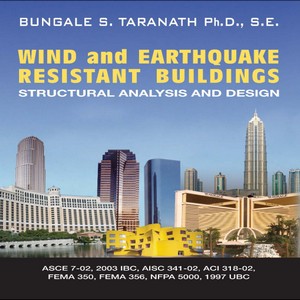Wind and earthquake resistant buildings
Structural analysis and design
Bungale S. Taranath
The primary objective of Wind and earthquake resistant buildings is to disseminate information on the latest concepts, techniques,
and design data to structural engineers engaged in the design of wind- and seismic-resistant buildings.
Integral to the Wind and earthquake resistant buildings are recent advances in seismic design, particularly those related to buildings in zones of low and moderate seismicity.
These stipulations, reflected in the latest provisions of American Society of Civil Engineers (ASCE) 7-02,
International Building Code (IBC)-03, and National Fire Protection Association (NFPA) 5000, are likely to be adopted as a design standard by local code agencies.
There now exists the unprecedented possibility of a single standard becoming a basis for earthquake-resistant design virtually in the entire United States, as well as in other nations that base their codes on U.S. practices.
By incorporating these and the latest provisions of American Concrete Institute (ACI) 318-02, American Institute of Steel Construction (AISC) 341-02, and Federal Emergency Management Agency (FEMA) 356 and 350 series,
this book equips designers with up-to-date information to execute safe designs, in accordance with the latest regulations.
It presents methods of determining design wind loads using the provisions of ASCE 7-02, National Building Code of Canada (NBCC) 1995, and 1997 Uniform Building Code (UBC). Wind-tunnel procedures are discussed, including analytical methods for determining along-wind and across-wind response.
It discusses the seismic design of buildings, emphasizing their behavior under large inelastic cyclic deformations.





Reviews
There are no reviews yet.